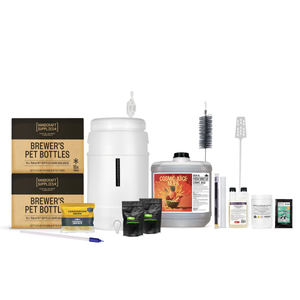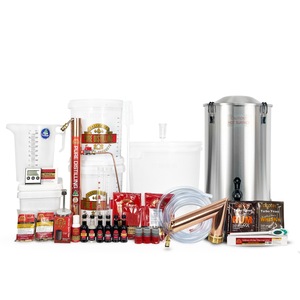
Nail Red Ale Style Extract Recipe Kit
Extract Recipe Kit
A complete extract recipe kit to brew 22L of juicy red ale.
Our extract recipe kits include high quality malt extracts, hops, steeping grains and style specific yeast. As our kits include specialty yeast we recommend checking the batch statistics section below to ensure you can ferment within the ideal fermentation temperature range.
Includes:
- Coopers Family Secret Amber Ale - 1.7kg
- Black Rock Unhopped Amber Malt Extract - 1.5kg
- Brew HQ Light Dried Malt Extract - 1kg
- Galaxy Hop Pellets - 100g
- Citra Hop Pellets - 100g
- Fermentis SafAle US-05 - 11g
Batch Stats:
Batch Volume: 22L
Approx ABV: 6.3%
Approx ABV (if bottling): 6.8%
Target OG: 1.062
Target FG: 1.014
Ideal Fermentation Temperature: 18-22°C
Instructions:
-
Reading: These instructions are generalised. Ignore instructions that do not pertain to your recipe. For example, don't worry about steeping grains or boiling hops if your recipe doesn't include grain or hops. Read through the instructions thoroughly before beginning. Ensure you fully understand the instructions before proceeding.
- Cleaning and Sanitation: Thoroughly clean and sanitise your fermenter and any equipment you plan on using during the brewing process. This may include stirring spoons, thermometers, jugs, and more. Ensure to carefully follow the instructions and dosages on your chosen cleaner and sanitiser.
- Using soluble ingredients: Your recipe will include some or all of the following soluble ingredients:
- Liquid malt extracts (usually in a can)
- Dried malt extracts
- Brew blends, kit converters, or brew enhancers
- Dextrose (glucose), maltodextrin (corn syrup), or lactose
To use these ingredients bring 2 litres of water to a gentle simmer in a small pot on the stovetop. Add all of your soluble ingredients into the pot and simmer for 5 minutes while you stir your mixture to ensure the ingredients fully dissolve. Some brew enhancers may contain hops or grain. We will want to strain these hops and grains from our mixture before adding them into the fermenter. After your ingredients have finished simmering, strain the liquid through a fine colander, mesh, or panty-hose to separate the solids from the hot liquid. Add the hot strained liquid to your sanitised fermenter. - Using Steeping Grains: Your recipe may contain steeping grains. These grains may be crushed or whole. If they are whole, put the grain inside a strong zip-lock bag and use a rolling pin to lightly crush the grains. Then, Bring 1 litre of water to a boil and add the grains. Gently simmer this mixture for 20 minutes, stirring frequently to stop the grain scorching. After steeping, strain the grain from the liquid using a fine colander, mesh, or panty-hose. Add the strained liquid into your fermenter.
- Using Boil (Bittering) Hops: Your recipe may contain bittering hops. Bring 1 litre of water to a boil on the stove and add the boil hops. Gently simmer this mixture for 20 minutes, stirring frequently. After 20 minutes, strain the hops from the liquid using a fine colander, mesh, or panty-hose. Add the strained liquid into your fermenter.
- At this stage, your fermenter will contain 2-6 litres of very hot concentrated wort. We want to add warm and cold water until our fermenter reaches the final batch volume indicated in the batch stats section and the temperature of our diluted wort falls within the ideal fermentation temperature. This means a recipe that ideally ferments between 12°C and 18°C would need much more cold water and less warm water added than a beer that ideally ferments between 22°C and 24°C.
- Take an original gravity (OG): Take a sample of wort using the tap into a hydrometer sample jar. Use the hydrometer to measure the specific gravity. The target gravity is listed in the batch stats section. Record your original gravity in the ‘your readings’ section for accurate ABV% calculation later. More information about using hydrometers can be found here.
- Double-check the temperature of your wort to ensure it falls within the ideal fermentation listed in the ‘batch stats section’ before adding the yeast. If it is too warm or cold, sit the fermenter in a hot water or ice water bath until the temperature falls within range. Fermentation temperature is extremely important to pay attention to if you want to make great beers.
- If the temperature is suitable, sprinkle the entire packet(s) of yeast across the surface of the wort. Add the lid to the fermenter, fit the airlock and ensure it is filled halfway with water. Check the fermenter periodically to ensure the fermentation temperature stays within the suggested range for your recipe.
- Using Dry Hops (Adding hop flavour): Your recipe may contain dry hops. Dry hops can be added at any point during fermentation. We recommend adding them on the 5th day of fermentation or when the Specific Gravity is below 1.020. Take a clean hop sock or bag and boil it in a few litres of water for 5 minutes to sterilise it. Add your hops to the hop sock and tie the open end of the bag ensuring there is enough room for the hops to swell when added to the beer. Open the lid of the fermenter and add the hop sock containing your dry hops to the fermenting beer. The hops can be left inside the fermenter for the remainder of fermentation.
- Check fermentation has finished: Your beer is finished fermenting when the specific gravity is stable for three consecutive days. This means taking hydrometer readings when airlock activity stops, or after approximately 7 days and making sure these readings are the same each day. This stable reading is your final gravity and can be used to calculate the ABV% of your beer. The target final gravity is indicated in the batch stats section under ‘target FG’.
-
Package your beer: Bottle or keg your beer following your standard procedure. More information pertaining to bottling and kegging can be found here:
Bottling 101: How to Bottle your beer
Kegging 101: How to keg your beer


